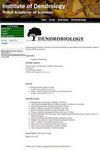种子质量和种子资源--测试木本植物的防御权衡假说
IF 1.4
4区 农林科学
Q2 FORESTRY
引用次数: 0
摘要
种子的物理和化学防御对植物的生存和繁殖至关重要。通过保护种子免受食草动物和其他威胁,植物可以确保其后代有更大的机会存活下来并长成成年植物。植物种子大小的变化会影响它们分配防御资源和养分的能力。与较大的种子相比,较小的种子往往含有较少的资源,在为萌芽幼苗分配防御资源或养分时可能会受到更多限制。在这项研究中,我们假设:(1) 种子中物理和化学防御与储备物质(在本研究中为 TNC 含量)之间的权衡与这些资源在种子中的分配有关;(2) 这些资源的分配方向受种子大小的影响。根据在波兰西部科尔尼克植物园收集的 77 种木本植物的种子,我们测量了几种种子的物理和化学特征:种子质量、总酚、单宁含量、粗纤维、木质素含量和非结构性碳水化合物总量。我们发现,化学防御(酚含量)和非结构性碳水化合物总量随种子质量的增加而增加,而物理防御(纤维含量)则与之相反。我们发现,植物在物理防御和化学防御之间的权衡往往受种子大小的影响。本文章由计算机程序翻译,如有差异,请以英文原文为准。
Seed mass and seed resources – testing the defense trade-off hypothesis in woody plants
Physical and chemical defenses of seeds are essential for plant survival and reproduction. By protecting their seeds from herbivores and other threats, plants can ensure that their offspring have a better chance of surviving and growing into adult plants. Plant seed-size variation can affect their ability to allocate defense resources and nutrients. Smaller seeds tend to contain fewer resources and are likely to be more constrained in resource allocation to defense or to nutrient supply for the germinating seedling than larger seeds. In this study, we hypothesized that (1) the trade-off between physical and chemical defenses and reserve materials (in this study TNC content) in seeds is related to the allocation of those resources to seeds, 2) the direction of allocation of these resources is mediated by seed size. Based on seeds of 77 woody plant species collected in the Kórnik Arboretum located in western Poland, we measured several physical and chemical seed traits: seed mass, total phenols, tannin content, crude fiber, lignin content, and total non-structural carbohydrates. We revealed that chemical defense (phenol content) and total non-structural carbohydrates increased with seed mass, whereas physical defense (fiber content) had the opposite effect. We found that the trade-off between physical and chemical defense in plants was often mediated by seed size.
求助全文
通过发布文献求助,成功后即可免费获取论文全文。
去求助
来源期刊

Dendrobiology
农林科学-林学
CiteScore
2.20
自引率
11.10%
发文量
17
审稿时长
>12 weeks
期刊介绍:
Dendrobiology publishes original research articles and review articles related to the biology of trees and shrubs.
 求助内容:
求助内容: 应助结果提醒方式:
应助结果提醒方式:


